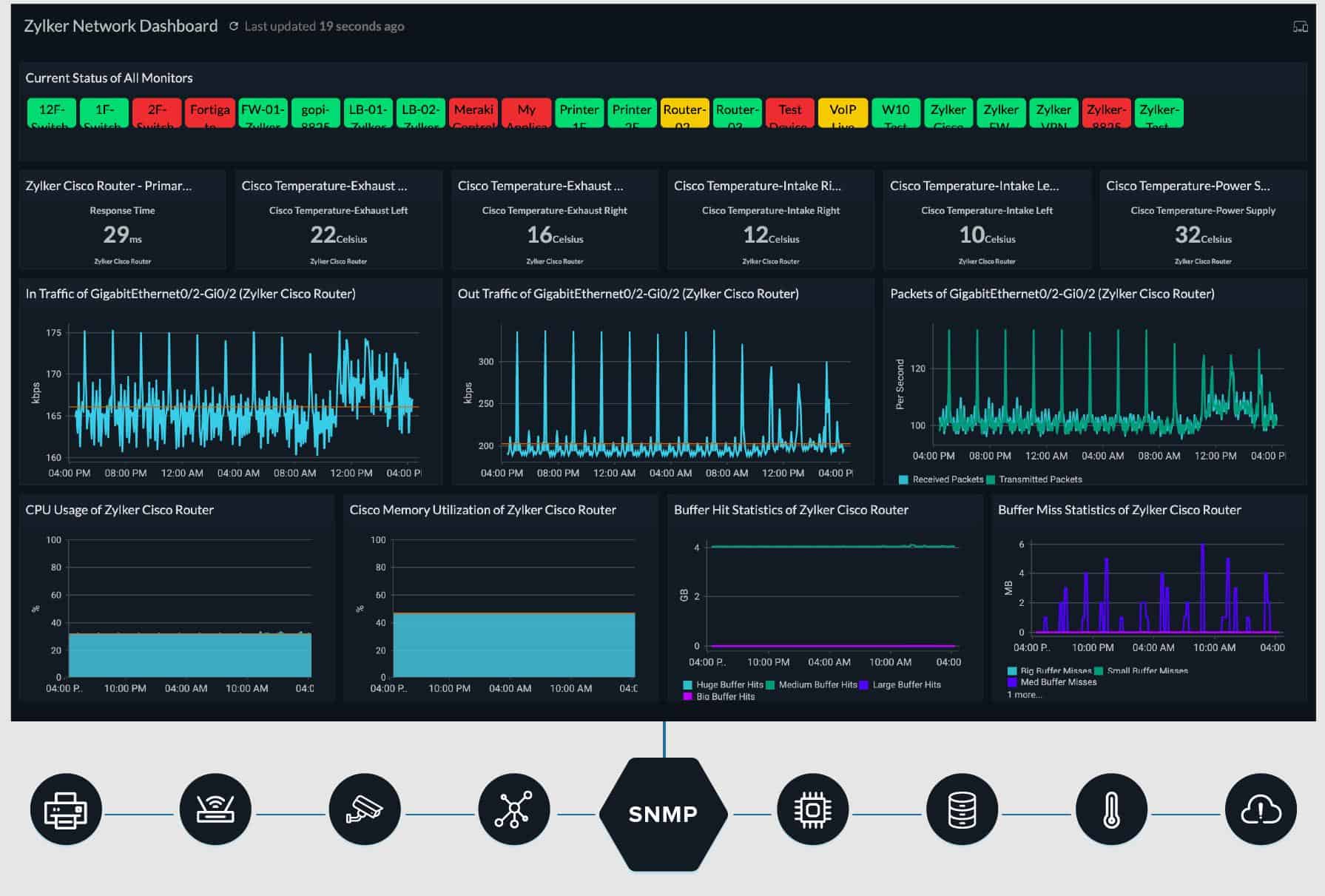We may earn a commission if you make a purchase through the links on our website.
The Best SmokePing Alternatives for Network & Latency Troubleshooting and Analysis
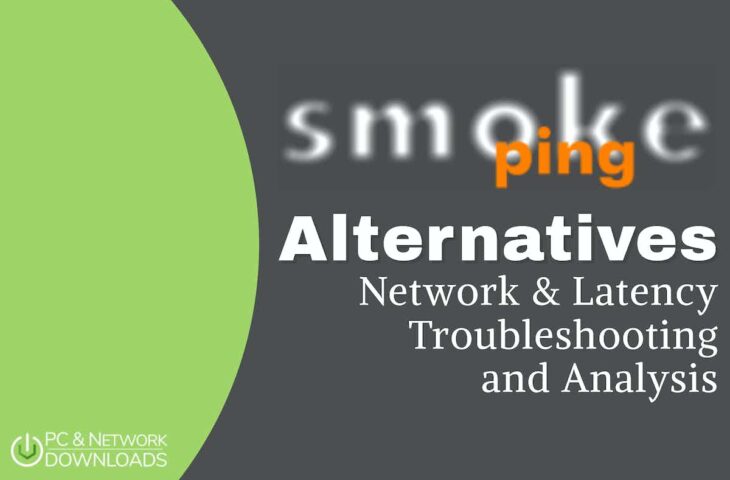
UPDATED: December 21, 2023
Monitoring software able to track latency can give you an overall perspective of the availability and health of your network. Other capabilities such as generating visual traceroutes or displaying packet loss percentages can also help you troubleshoot network issues.
A popular open-source network latency monitoring tool is SmokePing, developed by Oetiker. This tool shows network performance by collecting data and displaying it in real-time through advanced graphics. SmokePing uses RRDTool to maintain its store and for the graphing back-end.
Here is our list of the best SmokePing alternatives:
- Site24x7 – EDITOR'S CHOICE An excellent choice for network and latency troubleshooting, offering real-time analytics and a user-friendly interface. Start a 30-day free trial.
- Paessler PRTG Network Monitor – FREE TRIAL A package of system monitoring tools that includes the option of a Ping testing service for connectivity checks. Available for Windows Server. Start a 30-day free trial.
- PingPlotter An attractive repetitive Ping service that also gives a graph of results over time. Available in free and paid versions for installation on Windows, macOS, and iOS.
- MTR A free connection tester that combines Ping with Traceroute but doesn’t have a continuous operation option. Available for Unix, Linux, and macOS.
- SolarWinds Traceroute NG This free tool offers the option of continuous availability tests to one or more targets and shows results live on the screen plus written to a log file.
- Nagios Available in free and paid versions. This monitoring package includes a device availability check that is based on a continuous Ping. Available for Linux but can run on Windows over a hypervisor.
- Cacti A free traffic grapher that uses Ping to discover network devices and test their availability. Available for Linux, Unix, and Windows.
- MultiPing A simple network connection tester that is based on Ping and allows previous tests to be relaunched with one click. Runs on Windows.
Although SmokePing has a good reputation and many network admins use it for collecting historical data, there are some characteristics that people don’t like, such as:
- It provides amazing graphical results, but nothing textual. SmokePing is not able to produce in-depth error reports.
- Although there is a team of developers and users removing existing problems, there is no official team currently working on upgrades.
- Dealing with PERL and environment management can be challenging.
- It does not provide enough information about incidents in the network that are not related to availability.
The Best SmokePing Alternatives
What should you look for in network troubleshooting tools?
We reviewed the market for SmokePing alternatives and analyzed the options based on the following criteria:
- A system that performs constant checks on network connectivity
- Graphical representations of traffic activity
- Alerts for evolving link capacity issues
- A package that is fully supported by a professional team
- A software provider that maintains a development group to create updates for newly discovered security issues
- A free assessment period or a free tool
- A free tool that is worth bothering with or a paid tool that offers good value for money
With these selection criteria in mind, we have picked a number of excellent alternatives to SmokePing. Most of these options, like SmokePing, are free to use. We have gone one better than SmokePing, which is only available for Unix and Linux, by finding equivalent tools for Windows as well.
1. Site24x7 – FREE TRIAL
In the realm of network and latency troubleshooting, Site24x7 emerges as a compelling alternative to SmokePing. Offering a comprehensive suite of monitoring tools, it excels in providing real-time analytics and troubleshooting solutions for network performance issues.
Key Features
- Real-time network performance monitoring
- Detailed analytics and reporting tools
- User-friendly interface
- Customizable alert systems
- Multi-platform support
Why do we recommend it?
We recommend Site24x7 for its comprehensive and user-friendly approach to network monitoring. It's particularly adept at identifying and troubleshooting latency issues, which is crucial for maintaining optimal network performance.
Its ability to monitor various aspects of network health, from server performance to website uptime, makes it particularly useful for IT professionals and network administrators. Site24x7 stands out with its user-friendly interface and detailed reporting features, enabling users to quickly identify and resolve network latency issues.
Who is it recommended for?
Site24x7 is ideal for IT professionals and network administrators who require a detailed and responsive tool for monitoring network health and performance. Its features cater well to those needing to quickly diagnose and address network latency and downtime issues.
Pros:
- Offers in-depth network performance insights
- User-friendly dashboard and reporting
- Customizable alerts for immediate issue identification
Cons:
- Can be overwhelming for beginners due to its extensive feature set
2. Paessler PRTG Network Monitor – FREE TRIAL
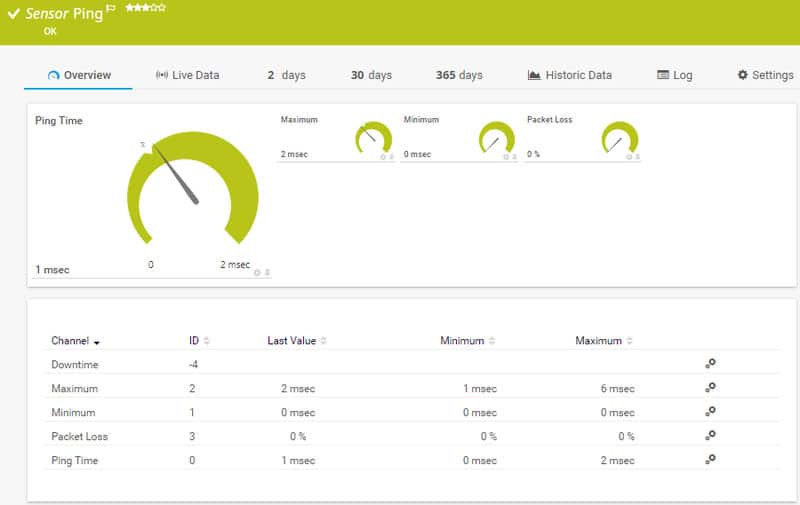
An agentless network monitoring software developed by Paessler GmbH. PRTG Network Monitor can monitor and analyze different network conditions and gather statistics from network devices or applications.
Key Features
- Comprehensive monitoring suite
- Flexible alerting system
- Easy-to-use web interface
- Extensive sensor library
Why do we recommend it?
We recommend Paessler PRTG for its extensive monitoring capabilities and flexible alerting system, making it a robust solution for network monitoring.
Although PRTG is far from a simple ping and traceroute tool, it is based on a system of sensors, which work based on pings. When a network element goes offline, PRTG will send alerts to let you know about the failure. The PRTG Sensor Ping can gather data and display maximum and minimum latencies, and packet loss in real time.
Why is it a good alternative to SmokePing? If you have the budget for a comprehensive monitoring application that goes beyond a simple ping, the benefits are beyond measure. PRTG has no match here. It can find, classify, and map all devices on the network. Then monitor them, alert failures, and create reports.
Who is it recommended for?
This tool is recommended for businesses of all sizes looking for a scalable and comprehensive network monitoring solution.
Pros:
- Uses a combination of packet sniffing, WMI, and SNMP to report network performance data
- A fully customizable dashboard is great for both lone administrators as well as NOC teams
- Drag and drop editor makes it easy to build custom views and reports
- Supports a wide range of alert mediums such as SMS, email, and third-party integrations into platforms like Slack
- Each sensor is specifically designed to monitor each application, for example, there are prebuilt sensors whose specific purpose is to capture and monitor VoIP activity
- Supports a freeware version
Cons:
- Is a very comprehensive platform with many features and moving parts that require time to learn
PRTG has six different price plans and one that is 100% free. The price is based on the number of sensors, rather than the number of monitored devices. Starting at PRTG500, which allows you to monitor 500 sensors for $1,600 a year. You can get an unlimited 30-day free trial version. Once expired, the license will revert to the %100 free PRTG100 for unlimited time.
3. PingPlotter
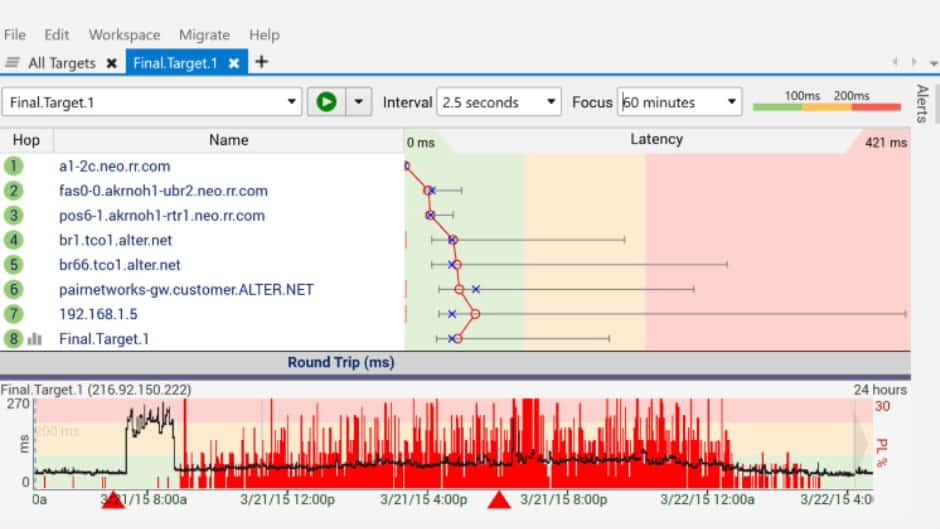
A networking diagnostic tool, PingPlotter combines ping, traceroute, and whois functionalities to collect data. The tool is able to graph packet loss and latency between source and destination. PingPlotter is a great tool for troubleshooting, it lets you know which hop is dropping packets.
Key Features
- Graphical traceroute tool
- Long-term monitoring
- Customizable alerts
- Windows and macOS compatible
Why do we recommend it?
PingPlotter is recommended for its graphical approach to traceroute analysis and its effectiveness in long-term network performance monitoring.
By visualizing the network performance graphs in detail, you’ll be able to find traffic bottlenecks and dead-ends in your network.
Why is it a good alternative to SmokePing? PingPlotter can be easily installed on Windows, MacOS, and iOS. Smokeping on the other hand relies on other tools and services to work. Aside from having Unix OS and Perl installed on a server, you’ll need other components.
Who is it recommended for?
Ideal for network technicians and end-users on Windows or macOS seeking a user-friendly tool for diagnosing network issues over time.
Pros:
- Three options including a freeware version
- Offers lightweight visualization into latency across devices
- Good for both one-off tests as well as continuous testing
Cons:
- Could benefit from a longer trial period
- TCP and UDP tests are not included in the free version
PingPlotter comes in three different editions. Purchase Professional for $199.95 with full features, Standard for $39.99 with limited features, or Free with basic features. Get a 14-day free trial of the PingPlotter Professional.
4. MTR
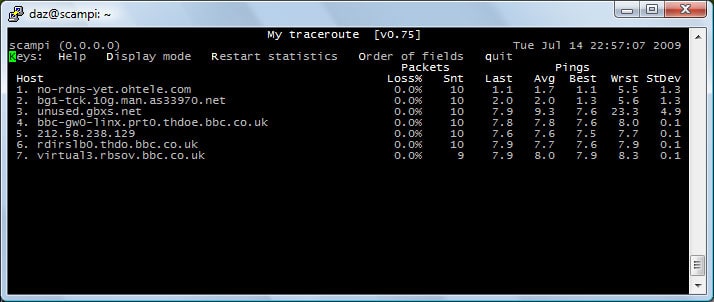
An open source project originally developed by BitWizard. My TraceRoute or commonly known as MTR is a network diagnostic tool that combines traceroute and ping functionalities. With its capabilities, MTR can analyze the network connection between the source (MTR host) and destination. The tool sends ICMP ECHO requests to the destination to determine the quality of the connection.
Key Features
- Combines Traceroute and Ping
- ICMP ECHO Requests
- Lightweight CLI Tool
- Analyzes Historical Data
Why do we recommend it?
MTR is recommended for its simplicity and effectiveness in conducting spot checks and troubleshooting network issues, especially for Unix-like OSs.
MTR is perfect for spot checks and troubleshooting. MTR is supported only by Unix-like OSs. A Windows equivalent to MTR was created by a different developer and is referred to as WinMTR.
Why is it a good alternative to SmokePing? MTR is frequently used for spot checks or troubleshooting. It is vulnerable to changes in traffic, such as packet loss and latency. MTR is better for collecting data close to the time of an event. But on the other hand, analyzing historical data is much easier with Smokeping, because it will monitor for an extended period of time.
Who is it recommended for?
Ideal for users who prefer a command-line interface and need a straightforward, open-source tool for real-time network analysis.
Pros:
- Open source and completely free
- Lightweight CLI tool – think traceroute and ping combined
- Can analyze and export historical data
Cons:
- No GUI – command line only
- Lacks data visualization
MTR is open source and free. You can get the software from a GitHub repository, or from BitWizard FTP at ftp://ftp.bitwizard.nl/mtr/ or https://www.bitwizard.nl/mtr/files.
Related Post: How to Use MTR Troubleshoot & Test your Connections
5. SolarWinds Traceroute NG
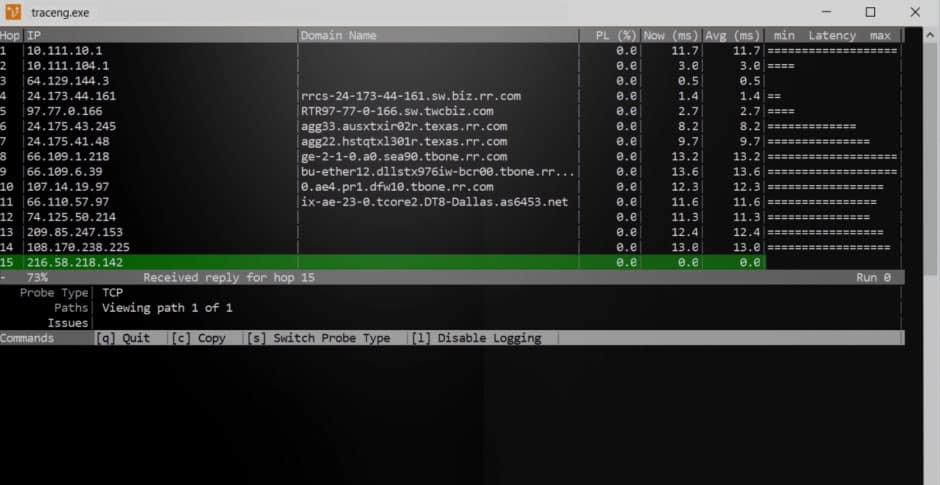
Traceroute NG from SolarWinds is an Upgrade from the Original command-line Traceroute tool that gives your a stand-alone version of a great network analysis and troubleshooting tool. With Continous TCP & ICMP tracing features and Hop-by-Hop analysis, this tool makes for a great addition to any Network Engineers toolbox.
Key Features
- Continuous TCP & ICMP tracing
- Hop-by-Hop analysis
- Lightweight and free
- Windows compatibility
Why do we recommend it?
We recommend SolarWinds Traceroute NG for its user-friendly enhancement of the classic Traceroute utility, providing detailed network analysis in a lightweight and free tool.
Traceroute NG allows your to trace routes and allow you to use any the following parameters for filtering and options:
| -a | Action to Take if path changes: Notify, Terminate or Warn (Default = Notify) |
| -d | Do not resolve address to hostname |
| -i | Force IP version: Ipv4 or IPv6 (default = IPv4) |
| -l | Log results to a File |
| -m | Maximum Hops (Default = 30 hops) |
| -p | Specfic target TCP Port |
| -r | Number of times the destination is probed (default = continuous) |
| -s | Select scan type: TCP or ICMP (default = TCP |
| -w | Response wait time in milliseconds (default = 500) |
| --help | Displays this help screen |
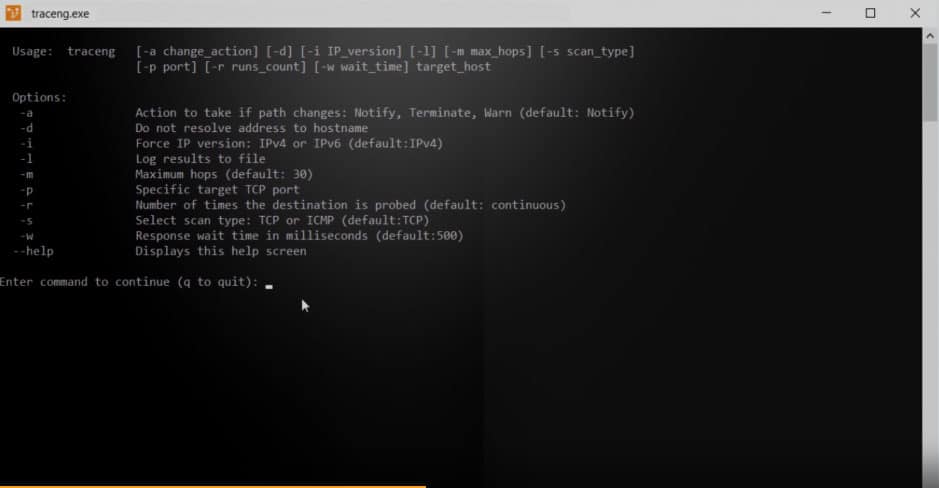
Who is it recommended for?
This tool is ideal for network engineers and IT professionals in Windows environments seeking a free, comprehensive network analysis solution.
Pros:
- Lightweight tool allows you to run it on virtually any network off of any machine
- Supports both IPv4 and IPv6, making it flexible or larger networks utilizing more modern protocols
- Acts as a troubleshooting tool to detect packet loss, jitter, and latency
- Offers simple visual representations of network traffic
- Is completely free
Cons:
- Advanced features such as alerting and network monitoring are not supported
6. Nagios
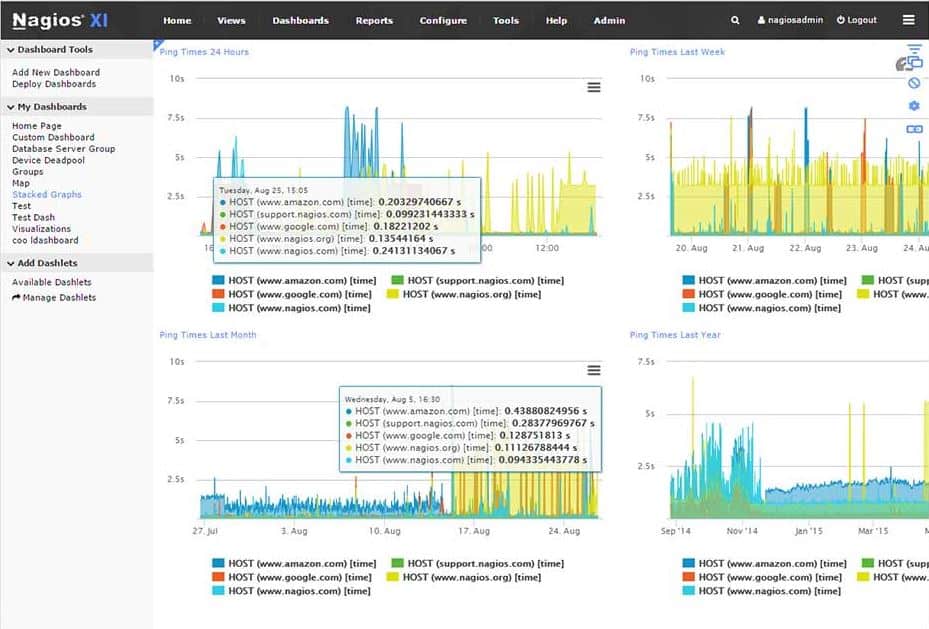
Nagios specializes in network monitoring software development. Their tools are capable of monitoring full networks, servers, or applications. Nagios has two important monitoring tools, Nagios Core which is free and open source, and Nagios XI which is the enterprise edition. Nagios is able to monitor networks and systems and find failures related to broken communication, connections in bad shape, or incorrect configurations.
Key Features
- Packet Loss Information
- Round Trip Averages
- Threshold Notifications
- HTML Output with Traceroute
Why do we recommend it?
Nagios is recommended for its robust monitoring capabilities, offering comprehensive insights into network and system failures.
The software provides complete monitoring capabilities with Ping, including packet loss and reachability. With Nagios, you can implement effective ping monitoring and troubleshoot availability issues. Nagios Core is known for its engaged community. The software is able to monitor almost anything you can imagine thanks to the official Nagios plugins and the ones created by the community.
Who is it recommended for?
Best suited for users who require a flexible, open-source tool for detailed network monitoring, with support for a wide range of plugins.
Pros:
- Open-source transparent tool
- Simple, yet informative interface
- Flexible alerting options support SMS and email
- Robust API backend makes it a great option for developers who want to integrate their own custom applications
Cons:
- Open-source version lacks the quality support found in paid products
- Installation can be technical and complex
Nagios Core is free and open source. Core XI starts at $1,995 for a standard license edition. Get the full and free Nagios Core, or download a full-featured 60-day trial of Core XI from Nagios official site.
7. Cacti

An open-source network monitoring and graphing tool. Cacti was built based on the data storage tool RRDTool. It also supports SNMP for network management and monitoring, and MRTG for graphing. Cacti is commonly used as a graphing tool for time-based metrics, such as network utilization or CPU. The web-based user interface makes it easy to monitor small to medium size networks.
Key Features
- Advanced Ping Monitoring
- Extensive Graphing Capabilities
- SNMP and MRTG Support
- Time-based Metrics Analysis
Why do we recommend it?
Cacti is recommended for its exceptional graphing capabilities and flexibility, making it a powerful tool for monitoring network utilization.
Similar to SmokePing, Cacti uses RRDTool to maintain its data store. Both products can only be installed in Unix and Linux distributions. The main difference is that SmokePing is much easier to install, while Cacti is a bit tricky.
But if you have the time to learn and install Cacti, you’ll reap the benefits. Cacti is very flexible, thanks to the support of thousands of plugins.
Who is it recommended for?
Ideal for researchers and network administrators who need a customizable, web-based interface for managing small to medium-sized networks.
Pros:
- Highly customizable monitor with a focus on data visualization
- Large dedicated community of over 20,000 members
- Simple interface
- Ideal for researchers looking for more flexibility in their data collection
Cons:
- Has a steep learning curve than competing products
- Like most open-source products, Cacti lacks a paid support option
Cacti is Free and open source. Get Cacti from its official site.
8. MultiPing
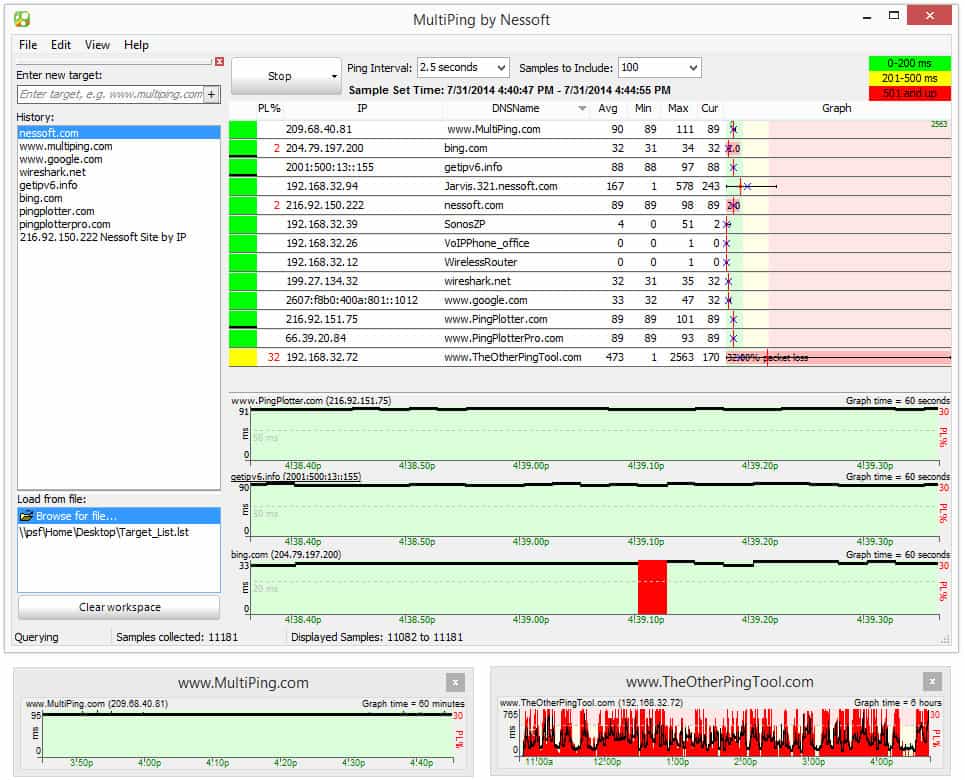
A lightweight tool for single or multiple target monitoring and alerting. MultiPing allows you to check multiple targets at the same time and provide historical information about the data collected. This information is displayed in a simple graphic format. The timeline graphing feature is one of the most powerful qualities of the software.
Key Features
- Network Performance Graphs
- Comprehensive Alert System
- Time Graphs
- Dynamic DNS Following
Why do we recommend it?
MultiPing is recommended for its ability to monitor and alert on multiple targets simultaneously, offering valuable historical data for network analysis.
With historic information, you can evaluate the uptime and quality of a link. The software displays key metrics such as packet loss in the graph.
MultiPing joined forces with PingPlotter for advanced troubleshooting. MultiPing gets help from PingPlotter to provide a per-hop delay, and MultiPing is great for finding latency trends on multiple sites. Both tools can give you a better toolset to monitor, diagnose, and find problems on a network target.
Who is it recommended for?
Suitable for tech support teams and users who require a tool for monitoring latency trends and diagnosing network issues across multiple sites.
Pros:
- Allows for network discovery and testing across multiple hosts
- Can measure packet loss, jitter, and latency across IPv4 and IPv6
- Good fit for smaller tech support teams or quick onsite scans
Cons:
- Only for Windows operating systems
- Paid tool, competing tools offer similar features for free
The single-user perpetual license is $39.99. Get a MultiPing trial for free.
SmokePing Alternatives FAQs
Are there any open-source alternatives to SmokePing?
Yes, there are open-source alternatives to SmokePing, such as Nagios and Cacti.
Can other network monitoring tools be used to monitor latency in the same way as SmokePing?
Yes, other network monitoring tools can be used to monitor latency, but the specific features and capabilities vary between tools.
What are some alternatives to SmokePing?
Some alternatives to SmokePing include: Nagios, Cacti, PRTG Network Monitor, and Zabbix.
